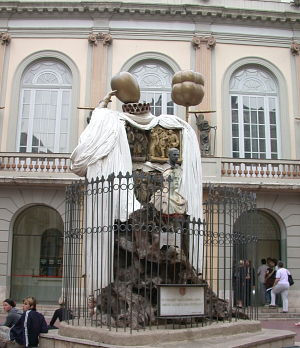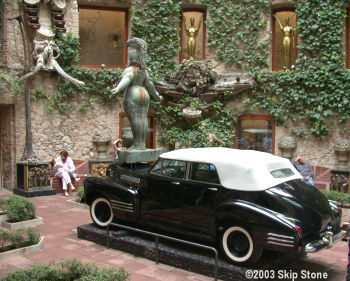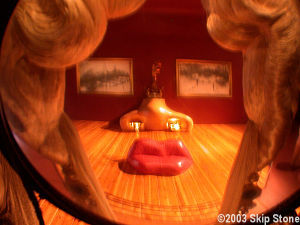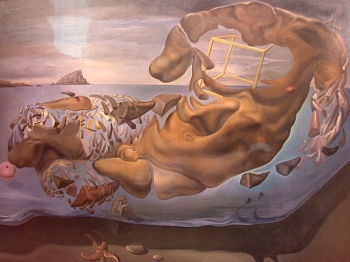There are actually three museums run by the Gala-Salvador Dalí Foundation. All are in the northeast corner of Spain known as Catalonia.
Firstly, in the town of Pubol is the Gala Dalí Castle House-Museum. This castle-like mansion was designed as a tribute to Salvador’s wife Gala, a space where she could live like royalty in rooms filled with Dalí’s artworks, and uncluttered spaces suitable for the grand visions of the master.
Near Cadaqués on the rocky coast is the second Salvador Dalí House-Museum, located in Port Lligat, opened to the public in 1997. This is the village in which Dalí stayed for lengthy periods during his childhood and youth. The rambling home sits on the side of a cove filled with fishing boats, and it’s made up from a cluster of fishermen’s huts structured in the form of a labyrinth. The house has an artist’s studio, library, and bedrooms open to the public.

Theater-Museum Dalí, Figueres
Thirdly, the “Theater-Museum Dalí” opened in Figueres in 1974. Dalí said at the time that, “the museum should not be considered as a museum, it is a gigantic surrealist object, everything inside is coherent, there is nothing that escapes from the webs of my understanding.” This collection includes everything from jewelry to sculpture, drawings and paintings, and room-sized fixed installations like the famed “Tribute to Mae West.” Displayed on the upper floors are many works by other artists, from El Greco to Vallès.

Courtyard in Dali Museum
In the center courtyard is an outdoor sculpture called “Rainy Cadillac.” A classic auto features a huge bronze statue standing on the hood like an oversized Valkyrie, and from behind the car sprouts a huge column adorned atop with a boat dripping huge globs of surrealistic blue water. When you peer in the windows of the Cadillac, you’ll see Salvador and Gala smiling and waving at you from the back seat, as they were often seen tooling around the local countryside.

Mae West Room
Born in Figueres in on May 11, 1904, the visionary Catalonian named Salvador Dali i Domènech was painting at an early age, and went to Madrid to study fine art in 1922. Here he met and was influenced by his avant-garde friends, poet Federico García Lorca and filmmaker Luis Buñuel. Involved with the production of a shocking little film by Buñuel called “Andalusian Dog,” Dali made a name for himself at an early age as an artist that would do anything to get his message across to the world.

Typical Surrealist Dalí Painting
In the late 1920’s Salvador Dalí decamped to Paris and joined a group of surrealist painters and sculptors. Here in Paris he created some of the most amazing Surrealistic art ever made. Masterpieces such as The Great Masturbator, The Spectre of Sex Appeal, The Lugubrious Game and The Persistence of Memory (Soft Watches) are from this time.
In the summer of 1929 the French poet Paul Éluard and his wife Helena Diakonova visited Dali at his Portlligat refuge, near Cadaqués in Spain. Also known as Gala, she decided on first sight to become his exclusive model, and lover. Although almost ten years older, she obviously dumped her husband immediately for the salacious and amazing young artist Salvador. Dalí became enraptured, and they were inseparable for the rest of her life. You can see her face floating serenely through many Dalí paintings and in other imagery and media.
During World War Two Dalí and Gala fled to America, where his dreamlike paintings met with a lot of success, and he became popular for pieces such as Soft Self-Portrait with Fried Bacon, Basket of Bread – Rather Death than Shame, Leda Atòmica and The Madonna of Portlligat. He also wrote “The Secret Life of Salvador Dalí.”
In 1948 he went back home to the Figueres region, and his place in Portlligat. Concerning his own “personal” home in Port Lligat Dalí said: “It was there I learnt to become poor, to limit and file down my thoughts so that they would acquire the sharpness of an axe, where blood tasted of blood and honey of honey. A life that was hard, without metaphor or wine, a life with the light of eternity.” Dalí delved deeply into religious themes during the next two decades while cranking out tons more work. Then in 1974 he opened the Theater-Museum in Figueres, with a grant from the Spanish government believe it or not, putting together this amazing masterpiece of surrealistic art.
After his wife Gala died, he spent the last years of his life in the Torre Galatea house in Figueres, near the Dalí Theatre-Museum, where he was buried. In the museum look for a blank stone set into the floor of the theater’s stage, under the geodesic dome. This is where Dalí is resting, hopefully in peace.

